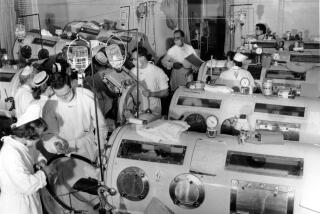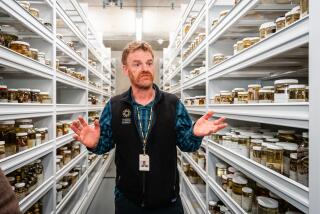Taking a Shot at a Medical Panacea
- Share via
BOGOTA, Colombia — The maverick scientist who shocked and divided the world of medical research a decade ago with his synthetic malaria vaccine is about to launch another volley.
Manuel E. Patarroyo says he is ready to prove that any contagious disease can be prevented with such a chemically generated vaccine. The evidence, he says, lies in a stack of papers in his Bogota laboratory that he plans to begin releasing for publication in scientific journals early next year.
Sliding his thumb up the stack, the slender chemist with thinning hair noted, “Seventeen million people die of infectious diseases worldwide every year.” Whether those deaths are from tuberculosis, malaria, respiratory infections, diarrhea or hepatitis, many could be prevented by chemical vaccines, he asserts.
At the Institute of Immunological Studies’ three-building campus, his team of physicists, mathematicians, biologists and chemists is even working on vaccines for AIDS and salmonella, using the same computer-generated models.
All of the diseases have completely different causes: acquired immune deficiency syndrome comes from a virus, malaria from a parasite and salmonella from a bacteria. To attack all of them with the same method is, to say the least, unconventional.
“We hope that this will be like the introduction of vaccines,” Patarroyo said of the work that he and his team of 180 young scientists--the average age is 27--have been preparing.
*
Patarroyo’s belief in the need for vaccines is widely shared among medical scientists. Antibiotics are becoming less effective in treatment as the parasites, bacteria and viruses that cause illness mutate and become resistant to antibiotics. For that reason, research into prevention, through vaccine, becomes a top priority.
Research into developing synthetic vaccines is recognized as a viable alternative to the trial-and-error testing to seek biological vaccines. The U.S. Navy, for example, is working to develop DNA-based vaccines.
As Patarroyo points out, once the formula is created, synthetic vaccines are extremely cheap to produce, easy to distribute (they do not require refrigeration) and have minimal negative side effects.
He opens what appears to be a mail tube and shakes out the contents into his hand, joking: “Fluffy, white Colombian powder.” This is malaria vaccine, made in Patarroyo’s laboratory, on its way to Tanzania in strikingly inexpensive packaging.
Up to this point, most medical research scientists would agree with Patarroyo. But his methods and approach to research have generated controversy, not to mention his open disdain for the formalities of the scientific community.
Patarroyo first provoked skepticism by attacking the complex disease malaria at a later stage in the development of the mosquito-borne parasite than do most researchers. Further, scientists, including Louis Miller of the National Institute of Allergy and Infectious Diseases in Bethesda, Md., have criticized him for moving quickly from animal testing to trials on thousands of humans.
*
Those criticisms gained force in 1990 when experts sent by the World Health Organization found that his trials did not meet their standards for control. Nevertheless, even once-harsh critics such as Ripley Ballou of the Walter Reed Army Institute of Research have since acknowledged that once they got used to formulating the complex vaccine, they were able to duplicate--and thus validate--Patarroyo’s test results.
Patarroyo believes that proteins are the key to preventing disease. As he explains it, proteins are like sentences made up of peptides (words), which in turn are composed of amino acids (letters).
He makes a computer map of an infection’s protein. From that, he picks out the key peptides, or words, as if he were writing a telegram. Those peptides, he explained, using another metaphor, are like the hands that an infection uses to grab its victim, a red blood cell.
Using the same peptides, he writes a different sentence: the vaccine. The message in that sentence makes the hands slide off the red blood cell. The patient remains healthy.
The vaccines are first tested on owl monkeys, which are native to Colombia, then on soldier volunteers. Women and children are the third group tested. Then come the field tests of thousands of people on various continents.
Not all of Patarroyo’s patients stay healthy. At most, his malaria vaccine has successfully immunized half the people injected in various tests around the world. That may not be comforting to tourists who want protection on vacation, but for people who live in disease-infested areas, it could reduce the chance that they will fall ill. And WHO officials say that would be an achievement.
*
The malaria vaccine, however, does not appear to provide equal protection wherever it is used. While results in Latin America have been promising, WHO tests in Gambia were less encouraging, and the vaccine appears to be ineffective in toddlers.
“The vaccine was a major breakthrough in terms of designing vaccines, but it is not finished,” said Dr. Fabio Ziecker, who heads the WHO’s malaria testing program. Patarroyo donated the patent for his vaccine to the organization.
“The vaccine is not used to control malaria,” said Ziecker. “It is still in the stage of testing. It is controversial.”
Nevertheless, Patarroyo has received recognition for his work. He was awarded Spain’s Prince of Asturias Scientific Investigation Prize in 1994.
“We were impressed by the originality of his approach in developing a synthetic vaccine and that he did not cede the rights to a pharmaceutical company, but gave them to a public organization so that the medicine could be distributed at a lower price,” said Dr. Jose Antonio Martinez, a member of the prize jury.
*
Patarroyo also has smoothed feathers by attending more scientific meetings, explaining his research to colleagues and listening to their criticism.
Even so, Patarroyo now is bracing for a new barrage of criticism as he announces his methodology for developing synthetic chemical vaccines.
“The first purpose of the institute was to show that vaccines could be made chemically,” he said. “We did that in 1987, but the vaccine was not perfect.”
Still, what he learned from that first experience will allow him to test the new vaccines more quickly by overlapping the tests, he said. Some vaccines could be available in five to seven years, he predicted.
“If pharmaceutical companies are threatened by that,” he said, “it’s not my problem.”






